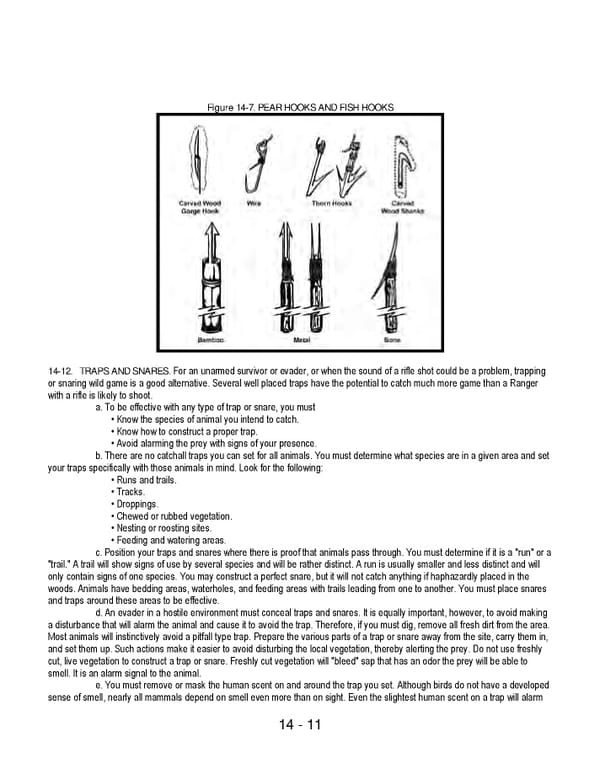14 - 11 Figure 14-7. PEAR HOOKS AND FISH HOOKS 14-12. TRAPS AND SNARES. For an unarmed survivor or evader, or when the sound of a rifle shot could be a problem, trapping or snaring wild game is a good alternative. Several well placed traps have the potential to catch much more game than a Ranger with a rifle is likely to shoot. a. To be effective with any type of trap or snare, you must • Know the species of animal you intend to catch. • Know how to construct a proper trap. • Avoid alarming the prey with signs of your presence. b. There are no catchall traps you can set for all animals. You must determine what species are in a given area and set your traps specifically with those animals in mind. Look for the following: • Runs and trails. • Tracks. • Droppings. • Chewed or rubbed vegetation. • Nesting or roosting sites. • Feeding and watering areas. c. Position your traps and snares where there is proof that animals pass through. You must determine if it is a "run" or a "trail." A trail will show signs of use by several species and will be rather distinct. A run is usually smaller and less distinct and will only contain signs of one species. You may construct a perfect snare, but it will not catch anything if haphazardly placed in the woods. Animals have bedding areas, waterholes, and feeding areas with trails leading from one to another. You must place snares and traps around these areas to be effective. d. An evader in a hostile environment must conceal traps and snares. It is equally important, however, to avoid making a disturbance that will alarm the animal and cause it to avoid the trap. Therefore, if you must dig, remove all fresh dirt from the area. Most animals will instinctively avoid a pitfall type trap. Prepare the various parts of a trap or snare away from the site, carry them in, and set them up. Such actions make it easier to avoid disturbing the local vegetation, thereby alerting the prey. Do not use freshly cut, live vegetation to construct a trap or snare. Freshly cut vegetation will "bleed" sap that has an odor the prey will be able to smell. It is an alarm signal to the animal. e. You must remove or mask the human scent on and around the trap you set. Although birds do not have a developed sense of smell, nearly all mammals depend on smell even more than on sight. Even the slightest human scent on a trap will alarm
 Ranger Handbook Page 258 Page 260
Ranger Handbook Page 258 Page 260